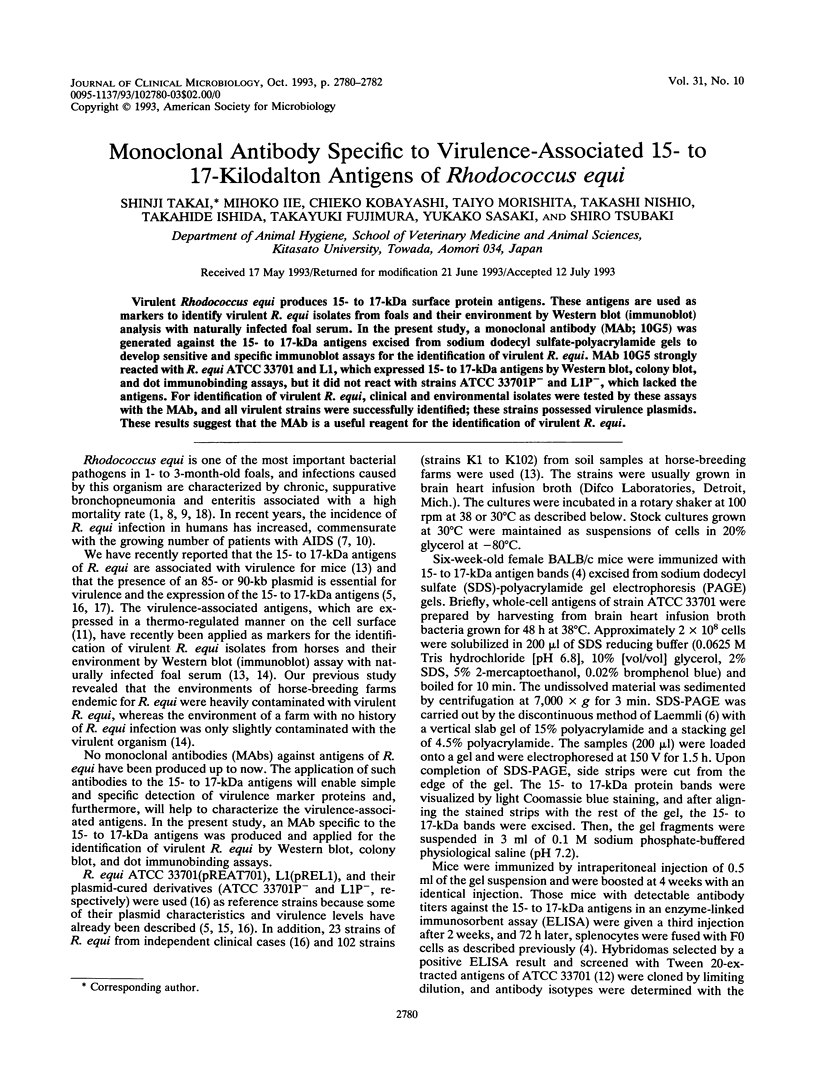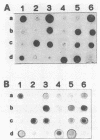Abstract
Virulent Rhodococcus equi produces 15- to 17-kDa surface protein antigens. These antigens are used as markers to identify virulent R. equi isolates from foals and their environment by Western blot (immunoblot) analysis with naturally infected foal serum. In the present study, a monoclonal antibody (MAb; 10G5) was generated against the 15- to 17-kDa antigens excised from sodium dodecyl sulfate-polyacrylamide gels to develop sensitive and specific immunoblot assays for the identification of virulent R. equi. MAb 10G5 strongly reacted with R. equi ATCC 33701 and L1, which expressed 15- to 17-kDa antigens by Western blot, colony blot, and dot immunobinding assays, but it did not react with strains ATCC 33701P- and L1P-, which lacked the antigens. For identification of virulent R. equi, clinical and environmental isolates were tested by these assays with the MAb, and all virulent strains were successfully identified; these strains possessed virulence plasmids. These results suggest that the MAb is a useful reagent for the identification of virulent R. equi.
Full text
PDF


Images in this article
Selected References
These references are in PubMed. This may not be the complete list of references from this article.
- Birnboim H. C., Doly J. A rapid alkaline extraction procedure for screening recombinant plasmid DNA. Nucleic Acids Res. 1979 Nov 24;7(6):1513–1523. doi: 10.1093/nar/7.6.1513. [DOI] [PMC free article] [PubMed] [Google Scholar]
- Finnerty W. R. The biology and genetics of the genus Rhodococcus. Annu Rev Microbiol. 1992;46:193–218. doi: 10.1146/annurev.mi.46.100192.001205. [DOI] [PubMed] [Google Scholar]
- Laemmli U. K. Cleavage of structural proteins during the assembly of the head of bacteriophage T4. Nature. 1970 Aug 15;227(5259):680–685. doi: 10.1038/227680a0. [DOI] [PubMed] [Google Scholar]
- Lasky J. A., Pulkingham N., Powers M. A., Durack D. T. Rhodococcus equi causing human pulmonary infection: review of 29 cases. South Med J. 1991 Oct;84(10):1217–1220. doi: 10.1097/00007611-199110000-00014. [DOI] [PubMed] [Google Scholar]
- Platt H. Septicaemia in the foal. A review of 61 cases. Br Vet J. 1973 May-Jun;129(3):221–229. doi: 10.1016/s0007-1935(17)36485-0. [DOI] [PubMed] [Google Scholar]
- Prescott J. F. Rhodococcus equi: an animal and human pathogen. Clin Microbiol Rev. 1991 Jan;4(1):20–34. doi: 10.1128/cmr.4.1.20. [DOI] [PMC free article] [PubMed] [Google Scholar]
- Samies J. H., Hathaway B. N., Echols R. M., Veazey J. M., Jr, Pilon V. A. Lung abscess due to Corynebacterium equi. Report of the first case in a patient with acquired immune deficiency syndrome. Am J Med. 1986 Apr;80(4):685–688. doi: 10.1016/0002-9343(86)90825-9. [DOI] [PubMed] [Google Scholar]
- Takai S., Iie M., Watanabe Y., Tsubaki S., Sekizaki T. Virulence-associated 15- to 17-kilodalton antigens in Rhodococcus equi: temperature-dependent expression and location of the antigens. Infect Immun. 1992 Jul;60(7):2995–2997. doi: 10.1128/iai.60.7.2995-2997.1992. [DOI] [PMC free article] [PubMed] [Google Scholar]
- Takai S., Kawazu S., Tsubaki S. Enzyme-linked immunosorbent assay for diagnosis of Corynebacterium (Rhodococcus) equi infection in foals. Am J Vet Res. 1985 Oct;46(10):2166–2170. [PubMed] [Google Scholar]
- Takai S., Koike K., Ohbushi S., Izumi C., Tsubaki S. Identification of 15- to 17-kilodalton antigens associated with virulent Rhodococcus equi. J Clin Microbiol. 1991 Mar;29(3):439–443. doi: 10.1128/jcm.29.3.439-443.1991. [DOI] [PMC free article] [PubMed] [Google Scholar]
- Takai S., Ohbushi S., Koike K., Tsubaki S., Oishi H., Kamada M. Prevalence of virulent Rhodococcus equi in isolates from soil and feces of horses from horse-breeding farms with and without endemic infections. J Clin Microbiol. 1991 Dec;29(12):2887–2889. doi: 10.1128/jcm.29.12.2887-2889.1991. [DOI] [PMC free article] [PubMed] [Google Scholar]
- Takai S., Sekizaki T., Ozawa T., Sugawara T., Watanabe Y., Tsubaki S. Association between a large plasmid and 15- to 17-kilodalton antigens in virulent Rhodococcus equi. Infect Immun. 1991 Nov;59(11):4056–4060. doi: 10.1128/iai.59.11.4056-4060.1991. [DOI] [PMC free article] [PubMed] [Google Scholar]
- Takai S., Watanabe Y., Ikeda T., Ozawa T., Matsukura S., Tamada Y., Tsubaki S., Sekizaki T. Virulence-associated plasmids in Rhodococcus equi. J Clin Microbiol. 1993 Jul;31(7):1726–1729. doi: 10.1128/jcm.31.7.1726-1729.1993. [DOI] [PMC free article] [PubMed] [Google Scholar]
- Tkachuk-Saad O., Prescott J. Rhodococcus equi plasmids: isolation and partial characterization. J Clin Microbiol. 1991 Dec;29(12):2696–2700. doi: 10.1128/jcm.29.12.2696-2700.1991. [DOI] [PMC free article] [PubMed] [Google Scholar]
- Yager J. A. The pathogenesis of Rhodococcus equi pneumonia in foals. Vet Microbiol. 1987 Aug;14(3):225–232. doi: 10.1016/0378-1135(87)90109-x. [DOI] [PubMed] [Google Scholar]





